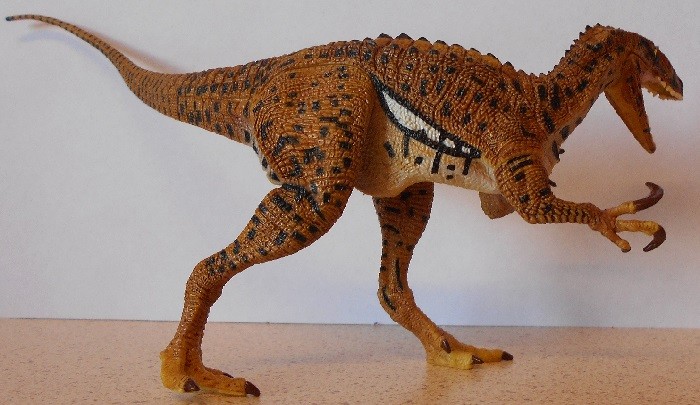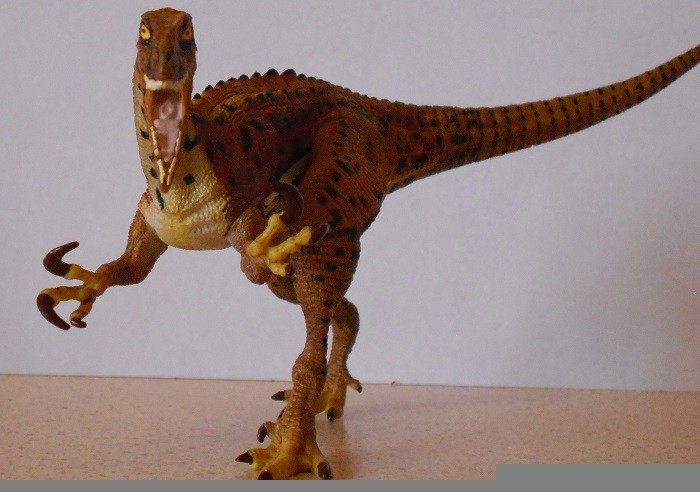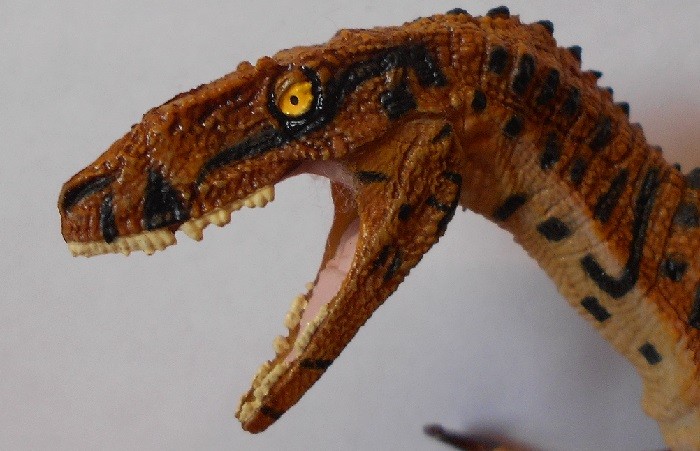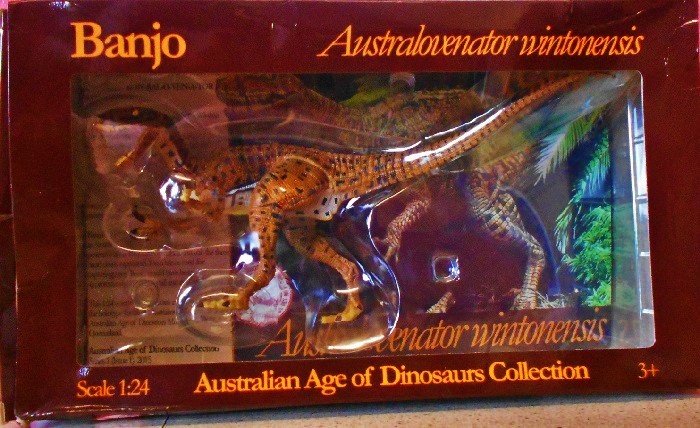Review and photos by Triceratops83, edited by Suspsy
Australovenator wintonensis is a megaraptoran theropod from Queensland and is Australia’s best known theropod from good remains. It comes from the Winton Formation which in the Early Cretaceous was a system of rivers and forests on the edge of the inland Eromaga Sea. Australovenator was discovered with the remains of the sauropod Diamantinasaurus matildae, on which it was likely scavenging. Australovenator has been nicknamed “Banjo,” after the poet Banjo Patterson who wrote the famous ballad “Waltzing Matilda” at Winton. This carnosaur was about the height of a human and probably grew to six metres long. Although Banjo is known only from incomplete remains consisting of limbs, lower jaw and a handful of ribs and gastralia, its image is widely recognised thanks to piece of paleoart by one of its discoverers–Travis R Tischler–depicting the animal as a lithe, leopard-printed predator with a narrow skull. This version of the dinosaur has appeared in life-sized statue form at the Australian Age of Dinosaurs Museum, and in the documentary Australia – A Time Traveller’s Guide. As for toys, Australovenator has been reproduced by Collecta and Geoworld.

This brings us to the highly anticipated model from the Australian Age Of Dinosaurs Museum. It is 1:24 scale, making it 21 cm long and 8 cm high. The figure depicts a lean predator and the view from the top presents a suitably skinny theropod. On the back is a row of scutes and the overall impression of the integument is very crocodile-like. The skull is narrow and the view from the front show symmetrical forward-facing eyes perfect for binocular vision. The body and limbs are bulging with muscle and the overall effect is a very lifelike toy.

Banjo is made from a sturdy plastic, which is only flexible at the tip of the tail. Like Papo’s dinosaurs, the AAOD figures are constructed from separately moulded pieces glued together. The fine detailing is exquisite, easily on par with Papo or Safari. The skin is pebbly and lizard-like, merging into crocodilian scales. Inside the mouth, the teeth appear very sharp and both the tongue and windpipe are visible. The paint application is superb, a desert yellow upper body merging into a pale white underside. The skin is decorated with a leopard-like pattern painted in a reptilian fashion. There is a white stripe between the arms and the legs. The sharp claws are painted a shiny brown and the interior of the mouth a soft pink. The figure’s only major drawback are the eyes, which are bright yellow with a black pupil–the effect is rather cartoonish compared with the realistic look of the rest of the animal.

Printed on the underside of the figure is the animal’s name and the address of the AAOD website. The toy, to my surprise, is able to stand on its skinny legs and is quite well balanced. Banjo comes in a box with a collectable information card. The figure is designed by Travis Tischler, who also did the artwork for the box. The AAOD Australovenator is ideal both as a collector’s piece, with its incredible detail, and as a child’s toy, depicting an awesome predator.

The AAOD Australovenator is available at the Australian Age of Dinosaurs website for about AU$30 and I highly recommend picking one up. Hopefully with our support this line of dinosaurs will continue to grow into a successful series of excellent prehistoric Australian figures.

Disclaimer: links to Ebay and Amazon on the DinoToyBlog are affiliate links, so we make a small commission if you use them. Thanks for supporting us!




Six years later, this figure still holds up nicely. Megaraptorids continue to be a weird bunch, and this is easily the best representation of the family on the toy market. I hope more people take the chance to get this figure and encourage the production of more Australian dinosaurs!
Really Good Work!
This is nice looking toy, figure, model. Maybe I am old school, but I do not need feathers on this “yet”. I love how the scales look on this with the paint job. Just wish the eyes were painted better.
It looks really nice but such a shame it’s already outdated in it’s prime. Far too scaly to be a tyrannosauroid.
It’ll certainly be interesting to see what the next toy from AAOD will be. Muttaburrasaurus or Kunbarrasaurus would be neat.
It looks really nice but such a shame it’s already outdated in it’s prime. Far too scaly to be a tyrannosauroid.
Australovenator was an Allosaurid.
A stunning piece, and a great review. I can’t wait to get my hands on one of these.